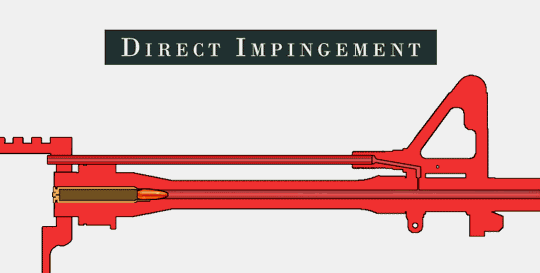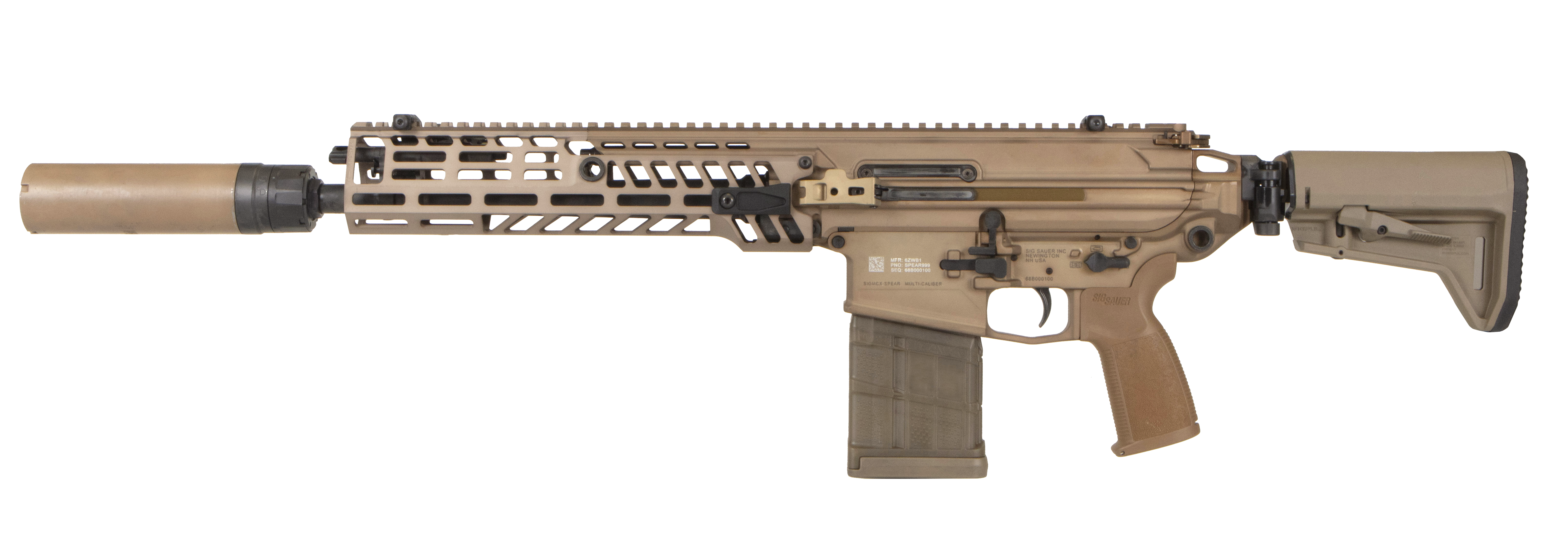|
Direct Impingement
Direct impingement is a type of gas operation for a firearm that utilizes gas from a fired cartridge to impart force on the bolt carrier or slide assembly to cycle the action. Firearms using direct impingement are theoretically lighter, more accurate, and less expensive than firearms using cleaner and cooler gas piston systems. Advantages Firearms with a direct impingement design can, in principle, be constructed lighter than piston-operated designs. Because high-pressure gas acts directly upon the bolt and carrier in a direct impingement system, it does not need a separate gas cylinder, piston, and operating rod assembly of a conventional piston-operated system, only requiring a gas tube to channel gas from the barrel back towards the action. This saves weight, lowers manufacturing costs, and reduces the mass of the operating parts, and thereby the wear on mechanical parts due to movement. By removing the gas piston, the potential amount of moving mass is also lowered, decreas ... [...More Info...] [...Related Items...] OR: [Wikipedia] [Google] [Baidu] [Amazon] |
MAS-49 Rifle
The MAS-49 is a French semi-automatic rifle that replaced various bolt-action rifles as the French service rifle that was produced from 1949. It was designed and manufactured by the government-owned Manufacture d'armes de Saint-Étienne, MAS arms factory.Huon, Jean; ''Proud Promise—French Semiautomatic Rifles: 1898–1979'', Collector Grade Publications, 1995. . The formal French Army designation of the MAS-49 is ''Fusil semi-automatique 7 mm 5 M. 49'' ("semi-automatic rifle of 7.5 mm model 1949"). Overall, the MAS-49 and 49/56 rifles gained the reputation of being accurate, reliable and easy to maintain in adverse environments. All the MAS-49 and 49/56 rifles feature a rail on the left side of their receivers to accommodate a designated rifle scope. The MAS-49 and MAS-49/56 were replaced as French service rifles by the FAMAS assault rifle starting in 1979. History The MAS-49 arrived after a series of small, distinct design improvements. Today, this might be termed spira ... [...More Info...] [...Related Items...] OR: [Wikipedia] [Google] [Baidu] [Amazon] |
Gas-delayed Blowback
Blowback is a system of operation for self-loading firearms that obtains energy from the motion of the cartridge case as it is pushed to the rear by expanding gas created by the ignition of the propellant charge. Several blowback systems exist within this broad principle of operation, each distinguished by the methods used to control bolt movement. In most actions that use blowback operation, the breech is not locked mechanically at the time of firing: the inertia of the bolt and recoil , relative to the weight of the bullet, delay opening of the breech until the bullet has left the barrel. A few locked breech designs use a form of blowback (example: primer actuation) to perform the unlocking function. The blowback principle may be considered a simplified form of gas operation, since the cartridge case behaves like a piston driven by the powder gases. Other operating principles for self-loading firearms include delayed blowback, blow forward, gas operation, and recoil operation ... [...More Info...] [...Related Items...] OR: [Wikipedia] [Google] [Baidu] [Amazon] |
Glossary Of Firearms Terminology
The following are terms related to firearms and topics. A B C D E F G H I J K L M N O P R S ... [...More Info...] [...Related Items...] OR: [Wikipedia] [Google] [Baidu] [Amazon] |
Piston Ring
A piston ring is a metallic split ring that is attached to the outer diameter of a piston in an internal combustion engine or steam engine. The main functions of piston rings in engines are: # Sealing the combustion chamber so that there is minimal loss of gases to the crank case. # Improving heat transfer from the piston to the cylinder wall. # Maintaining the proper quantity of the oil between the piston and the cylinder wall # Regulating engine oil consumption by scraping oil from the cylinder walls back to the sump. Most piston rings are made from cast iron or steel. Design Piston rings are designed to seal the gap between the piston and the cylinder wall. If this gap were too small, thermal expansion of the piston could mean the piston seizes in the cylinder, causing serious damage to the engine. On the other hand, a large gap would cause insufficient sealing of the piston rings against the cylinder walls, resulting in excessive blow-by (combustion gases entering th ... [...More Info...] [...Related Items...] OR: [Wikipedia] [Google] [Baidu] [Amazon] |
M4 Carbine
The M4 carbine (officially Carbine, Caliber 5.56 mm, M4) is a 5.56×45mm NATO assault rifle developed in the United States during the 1980s. It is a shortened version of the M16A2 assault rifle. The M4 is extensively used by the US military, with decisions to largely replace the M16 rifle in US Army (starting 2010) and US Marine Corps (starting 2016) combat units as the primary infantry weapon and service rifle. The M4 has been adopted by over 60 countries worldwide, and has been described as "one of the defining firearms of the 21st century." Since its adoption in 1994, the M4 has undergone over 90 modifications to improve the weapon's adaptability, ergonomics and modularity, including: the M4A1, which possesses a thicker barrel and a replacement of the burst-fire control group with a fully automatic one; the SOPMOD, an accessory kit containing optical attachments; and the underbarrel weapons such as M203 and M320 grenade launchers to the Masterkey and M26-M ... [...More Info...] [...Related Items...] OR: [Wikipedia] [Google] [Baidu] [Amazon] |
M16 Rifle
The M16 (officially Rifle, Caliber 5.56 mm, M16) is a family of assault rifles adapted from the ArmaLite AR-15 rifle for the United States Armed Forces, United States military. The original M16 was a 5.56×45mm NATO, 5.56×45mm automatic rifle with a 20-round magazine. In 1964, the XM16E1 entered US military service as the M16 and in the following year was deployed for jungle warfare operations during the Vietnam War. In 1969, the M16A1 replaced the M14 rifle to become the US military's standard service rifle. The M16A1 incorporated numerous modifications including a bolt-assist ("forward-assist"), chrome-plated bore, protective reinforcement around the magazine release, and revised flash hider. In 1983, the United States Marine Corps, US Marine Corps adopted the M16A2 rifle, and the United States Army, US Army adopted it in 1986. The M16A2 fires the improved 5.56×45mm (M855/SS109) cartridge and has a newer adjustable rear sight, case deflector, heavy barrel, improved ha ... [...More Info...] [...Related Items...] OR: [Wikipedia] [Google] [Baidu] [Amazon] |
ArmaLite AR-15
The ArmaLite AR-15 is a gas-operated assault rifle manufactured in the United States between 1959 and 1964. Designed by American gun manufacturer ArmaLite in 1956, it was based on its AR-10 rifle. The ArmaLite AR-15 was designed to be a lightweight rifle and to fire a new high-velocity, lightweight, small-caliber cartridge to allow infantrymen to carry more ammunition. In 1959, ArmaLite sold its rights to the AR-15 to Colt due to financial difficulties and limitations in terms of manpower and production capacity. After modifications (most notably, the charging handle was re-located from under the carrying handle like AR-10 to the rear of the receiver),Kokalis, Peter GRetro AR-15 nodakspud.com Colt rebranded it the Colt 601, however, it still carried the Armalite markings due to contractual obligations to Armalite/Fairchild Aircraft Co. Colt marketed the redesigned rifle to various military services around the world and was eventually adopted by the U.S. military in January ... [...More Info...] [...Related Items...] OR: [Wikipedia] [Google] [Baidu] [Amazon] |
Eugene Stoner
Eugene Morrison Stoner (November 22, 1922 – April 24, 1997) was an American machinist and firearms designer who is most associated with the development of the ArmaLite AR-15 rifle that was redesigned and modified by Colt's Manufacturing Company, Colt's Patent Firearm Company for the United States military as the M16 rifle. Early life Stoner was born in Gosport, Indiana, on November 22, 1922. He moved to Long Beach, California where he graduated from Long Beach Polytechnical High School. In 1939, after the Depression, there was not enough money for him to attend college, so he went to work as a machinist for Vega Aircraft Company, the forerunner of what became Lockheed Airplane Company (now the Lockheed Martin Corporation). During World War II, World War II, he enlisted for Aviation Ordnance in the United States Marine Corps, U.S. Marine Corps and served in the South Pacific Area, South Pacific and northern China. In the Corps, he had his first experience of working with ... [...More Info...] [...Related Items...] OR: [Wikipedia] [Google] [Baidu] [Amazon] |
M16 Rifle Firing FM 23-9 Fig 2-7
The M16 (officially Rifle, Caliber 5.56 mm, M16) is a family of assault rifles adapted from the ArmaLite AR-15 rifle for the United States Armed Forces, United States military. The original M16 was a 5.56×45mm NATO, 5.56×45mm automatic rifle with a 20-round magazine. In 1964, the XM16E1 entered US military service as the M16 and in the following year was deployed for jungle warfare operations during the Vietnam War. In 1969, the M16A1 replaced the M14 rifle to become the US military's standard service rifle. The M16A1 incorporated numerous modifications including a bolt-assist ("forward-assist"), chrome-plated bore, protective reinforcement around the magazine release, and revised flash hider. In 1983, the United States Marine Corps, US Marine Corps adopted the M16A2 rifle, and the United States Army, US Army adopted it in 1986. The M16A2 fires the improved 5.56×45mm (M855/SS109) cartridge and has a newer adjustable rear sight, case deflector, heavy barrel, improved ha ... [...More Info...] [...Related Items...] OR: [Wikipedia] [Google] [Baidu] [Amazon] |
Automatgevär M/42
The Automatgevär m/42 (Ag m/42, outside of Sweden commonly known as the AG 42, AG-42 or Ljungman) is a Swedish semi-automatic rifle which saw limited use by the Swedish Army from 1942 until the 1960s. History During the Winter War, Finland captured a number of SVT-38 rifles, and at least one found its way to Sweden. The Ag m/42 was designed by Erik Eklund of the AB C.J. Ljungmans Verkstäder company of Malmö, loosely following SVT mechanics around 1941, and entered production at the Carl Gustafs Stads Gevärsfaktori in Eskilstuna in 1942. Some 30,000 rifles were manufactured in all for the Swedish Army. This was a relatively small number of weapons and the standard infantry rifle remained the 6.5 mm bolt-action m/96 Mauser. Norwegian "police troops" trained in Sweden during World War II were issued a number of Ag m/42s and brought these rifles to Norway when the Germans surrendered in 1945. These rifles were never modified to the later Ag m/42B version. After a numbe ... [...More Info...] [...Related Items...] OR: [Wikipedia] [Google] [Baidu] [Amazon] |
Rossignol ENT
The Rossignol ENT was an experimental automatic rifle of French origin from around the first years of the 20th century. It was the first rifle which used the direct impingement operating system, which found later use in the Swedish Ag m/42, the French 1940 MAS and, most notably, the AR-10 and AR-15 series of rifles. Rossignol developed the new impingement system, and modified the Friberg-Kjellman system of opposing, retractable bolt lugs for this experimental rifle. The rifle was produced under the École Normale de Tir École or Ecole may refer to: * an elementary school in the French educational stages normally followed by secondary education establishments (collège and lycée) * École (river), a tributary of the Seine flowing in région Île-de-France * Éco ..., thus the ENT designation, and was produced in at least four variants, "ENT No. 1 or B1, B2, B4, B5". Specifications * Cartridge: 6×60mm * Caliber: 6mm * Weight: 9.7 kg * Operation: Gas direct-impingement ... [...More Info...] [...Related Items...] OR: [Wikipedia] [Google] [Baidu] [Amazon] |







